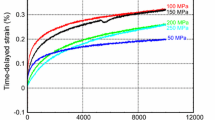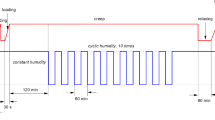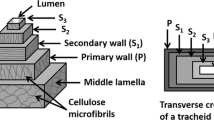Abstract
The increased creep rate of paper under load during moisture cycling conditions as compared to that at high constant humidity is a problem in the use of packaging materials. In order to investigate the influence of morphological factors of the fibres on the occurrence and magnitude of this phenomenon, i.e. the occurrence of mechano-sorptive creep, studies on wood fibres isolated from different parts of spruce wood were performed. Thus, creep properties were studied on earlywood and latewood fibres from both juvenile wood and mature wood. In general, latewood fibres showed a higher degree of mechano-sorptive creep than earlywood fibres, and mature wood showed a higher degree of mechano-sorptive creep than juvenile fibres. The difference in mechano-sorptive creep rate between different fibres was shown to be correlated to the differences in fibril angle. The smaller the fibril angle the higher was the mechano-sorptive creep ratio. It was suggested that at fibril angles approaching 45° wood fibres do not exhibit mechano-sorptive creep.




Similar content being viewed by others
References
Alfthan J (2004) Micro-mechanically based modeling of mechano-sorptive creep in paper. Solid mechanics. KTH, Stockholm
Bazant ZP (1985) Constitutive equation of wood at variable humidity and temperature. Wood Sci Technol 19:159–177
Bergander A, Salmén L (2002) Cell wall properties and their effects on the mechanical properties of fibers. J Mater Sci 37(1):151–156
Bergander A, Brändström J, Daniel G, Salmén L (2002) Fibril angle variability in earlywood of Norway spruce using soft rot cavities and polarization confocal microscopy. J Wood Sci 48(4):255–263
Bethe E (1969) Strength properties of construction wood stored under changing climates and mechanical load. Holz Roh-Werkst 27(8):291–303
Burgert I, Keckes J, Frühmann K, Fratzl P, Tschegg SE (2002) A comparison of two techniques for wood fibre isolation–evaluation by tensile tests on single fibres with different microfibril angle. Plant Biol 4:9–12
Burgert I, Gierlinger N, Zimmermann T (2005) Properties of chemically and mechanically isolated fibres of spruce (Picea abies [L.] Karst.). Part 1. Structural and chemical characterization. Holzforschung 59:240–246
Cave ID (1968) The anisotropic elasticity of the plant cell wall. Wood Sci Technol 2:268–278
Cave ID (1969) The longitudinal Young’s modulus of Pinus radiata. Wood Sci Technol 3:40–48
Eriksson L, Norén B (1965) The effect of moisture changes on the deformation of wood with tension in fibre direction. Holz Roh-Werkst 23(5):201–209
Gibson EJ (1965) Creep of wood: role of water and effect of a changing moisture content. Nature 206(4980):213–215
Groom L, Mott L, Shaler S (2002) Mechanical properties of individual southern pine fibers. Part I. Determination and variability of stress–strain curves with respect to tree height and juvenility. Wood Fiber Sci 34:14–27
Habeger CC, Coffin DW (2000) The role of stress concentrations in accelerated creep and sorption-induced physical aging. J Pulp Paper Sci 26(4):145–157
Habeger CC, Coffin DW, Hojjatie B (2001) Influence of humidity cycling parameters on the moisture-accelerated creep of polymeric fibers. J Polym Sci B Polym Phys 39(17):2048–2062
Haslach HW (1994) The mechanics of moisture accelerated tensile creep in paper. Tappi 77(10):179–186
Jang HF (1998) Measurement of fibril angle in wood fibres with polarization confocal microscopy. J Pulp Paper Sci 24(7):224–230
Kantola M, Seitsonen S (1969) On the relation between tracheid length and microfibrillar orientation measured by X-ray diffraction in conifer wood. Ann Acad Sci Fenn A VI Phys 300:1–10
Kretschmann DE, Alden HA, Verrill S (1998) Variations of microfibril angle in loblolly pine: comparison of iodine crystallization and X-ray diffraction techniques. In: Butterfield BG (ed) Microfibril angle m in wood. Univ. Canterbury, Christchurch, pp 157–176
Meylan BA (1968) Cause of high longitudinal shrinkage in wood. For Prod J 18(4):75–78
Navi P, Pittet V, Plummer CJG (2002) Transient moisture effects on wood creep. Wood Sci Technol 36:447–462
Olsson A-M, Salmén L, Eder M, Burgert I (2007) Mechano-sorptive creep in wood fibres. Wood Sci Technol 41(1):59–67
Padanyi ZV (1993) Physical aging and glass transition: effects on the mechanical properties of paper and board. In: Baker CF (ed) Products of papermaking. Pira International Leatherhead, UK, pp 521–545
Page DH, El-Hosseiny F (1983) The mechanical properties of single wood pulp fibres. Part VI. Fibril angle and the shape of the stress-strain curve. J Pulp Paper Sci, Trans Techn Sect 9(4):TR 99–100
Persson K (2000) Micromechanical modelling of wood and fiber properties. Ph.D. thesis. Dep. Mechanics and Materials, Lund University, Lund
Sahlberg U, Salmén L, Oscarsson A (1997) The fibrillar orientation in the S2-layer of wood fibres as determined by X-ray diffraction analysis. Wood Sci Technol 31:77–86
Salmén L (1986) The cell wall as a composite structure. In: Bristow JA, Kolseth P (eds) Paper structure and properties. Marcel Dekker Inc., New York, pp 51–73
Sedlachek KM (1995) The efffect of hemicelluloses and cyclic humidity on the creep of single fibers. Ph.D. thesis. Inst Paper Sci Technol, Univ. Georgia Tech., Atlanta
Sedlachek KM, Ellis RL (1994) The effect of cyclic humidity on the creep of single fibers of Southern pine. In: Fellers C, Laufenberg TL (eds) Moisture-induced creep behaviour of paper and board. STFI, USDA, Stockholm, pp 22–49
Söremark C, Fellers C (1993) Mechano-sorptive creep and hygroexpansion of corrugated board in bending. J Pulp Paper Sci 19(1):J19–26
Söremark C, Fellers C, Henriksson L (1993) Mechano-sorptive creep of paper—influende of drying restraint and fibre orientation. In: Baker CF (ed) Products of papermaking. FRC. 1:547–574
Wang JZ, Dillard DA, Wolcott MP, Kamke FA, Wilkes GL (1990) Transient moisture effects in fibers and composite materials. J Compos Mater 24:994–1009
Acknowledgments
This study has been conducted as part of a Master Thesis work by Fang Dong.
Author information
Authors and Affiliations
Corresponding author
Rights and permissions
About this article
Cite this article
Dong, F., Olsson, AM. & Salmén, L. Fibre morphological effects on mechano-sorptive creep. Wood Sci Technol 44, 475–483 (2010). https://doi.org/10.1007/s00226-009-0300-3
Received:
Published:
Issue Date:
DOI: https://doi.org/10.1007/s00226-009-0300-3




